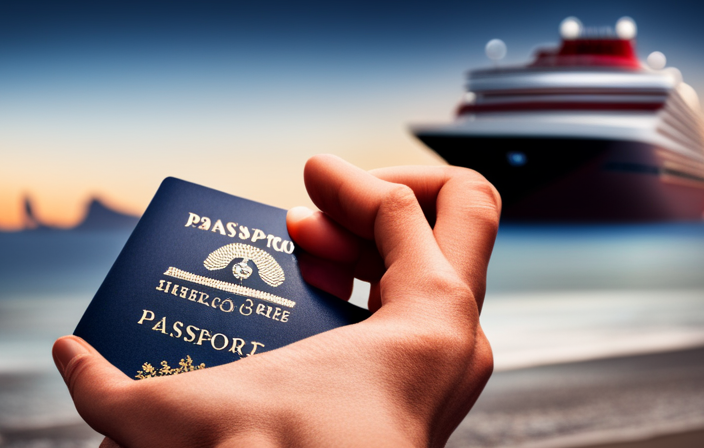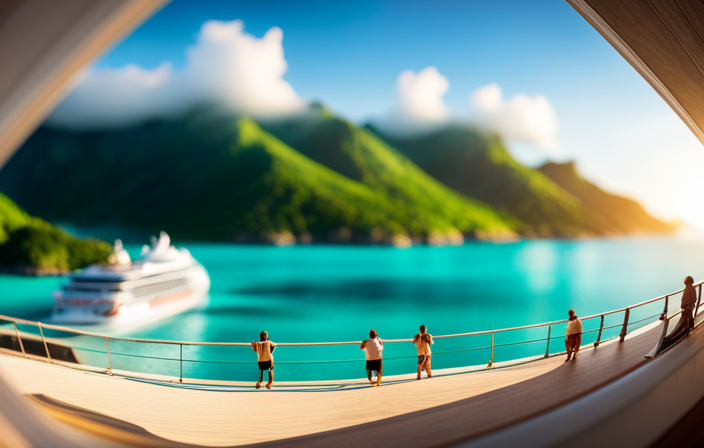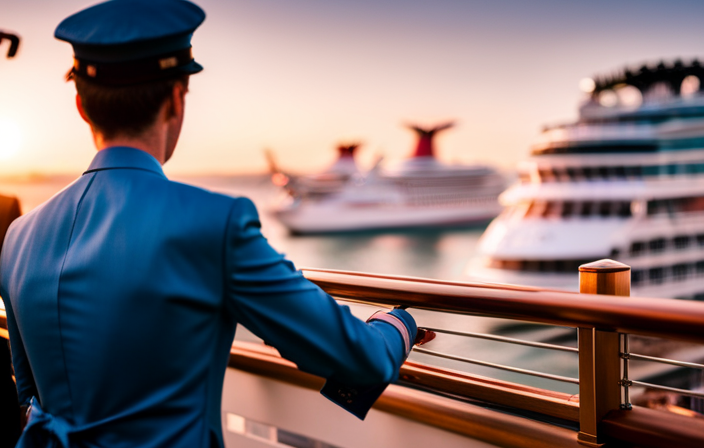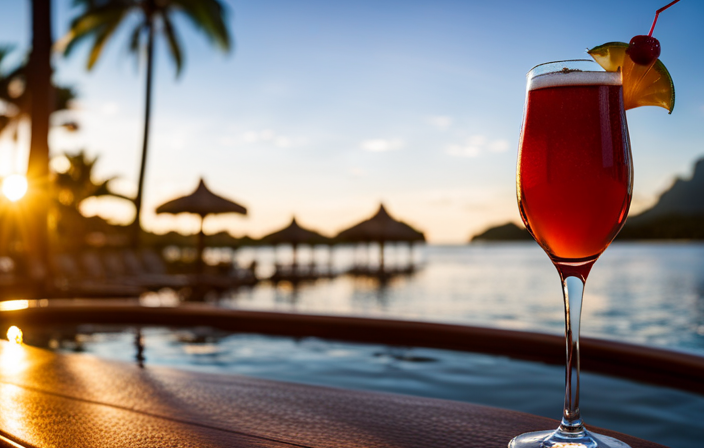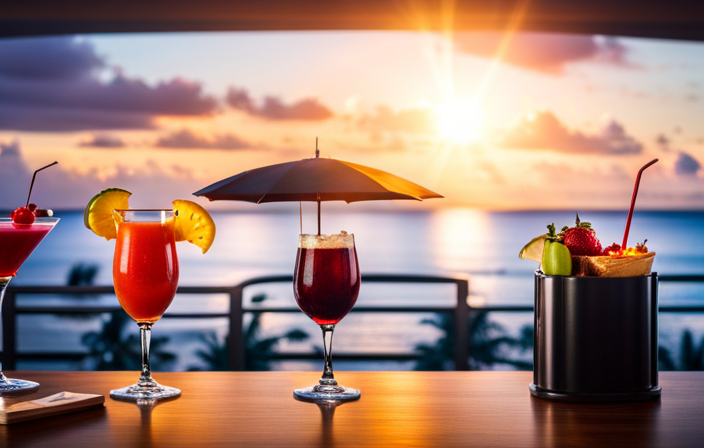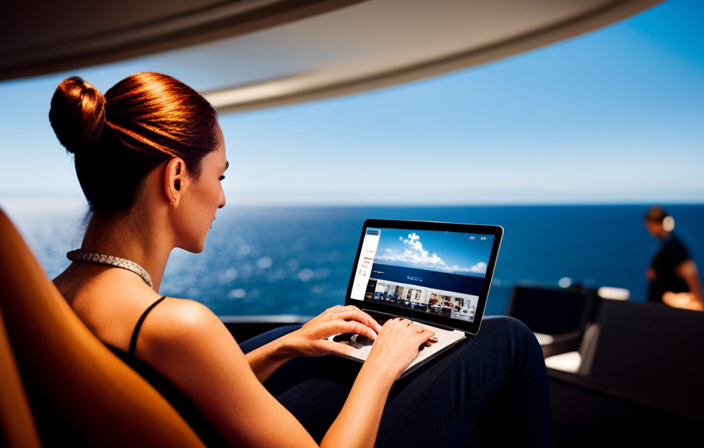Cruise FAQs
Answering Offbeat Cruise Ship Questions
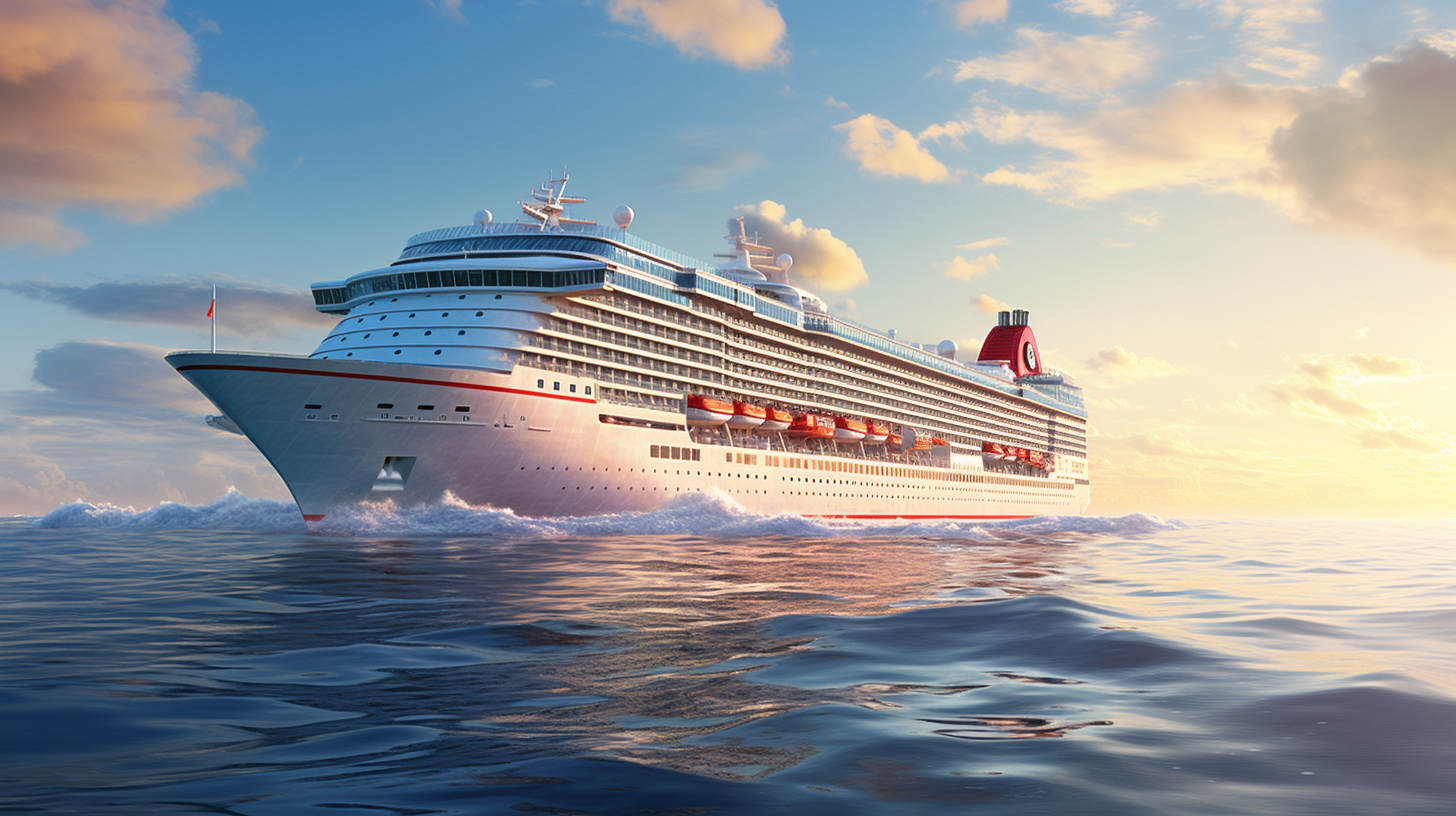
Introduction
Greetings, adventurous navigators! Are you prepared to journey through the vast cosmos of cruise ships and discover some unique mysteries? You’ve arrived at the perfect spot. In this blog post, our goal is to address a variety of uncommon questions that frequently arise in discussions about cruise ships.
From mysterious jail cells to peculiar bathroom habits, we’ll leave no stone unturned. So please sit back, relax (preferably with a fruity drink in hand), and get ready for some unexpected answers as we unravel the mysteries of cruising like never before! Whether you’re a seasoned sailor or dreaming of your first voyage, prepare for an enlightening and entertaining journey through these lesser-known aspects of life on the high seas.
Ahoy there – let’s set sail on our quest to answer your most burning cruise ship cabin questions!
What Is a Cruise Ship Jail?
Cruise ships are like floating cities, complete with restaurants, entertainment venues, and even their own jails. Yes, you read that right – cruise ship jails exist! But before you start picturing a dark and dingy cell below deck, let’s explore what exactly a cruise ship jail is.
Contrary to popular belief, cruise ship jails are not designed for criminals or dangerous individuals. Instead, they serve as temporary holding areas for passengers who have broken the rules or engaged in disruptive behavior. These “jails” are often small rooms or cabins that have been repurposed to temporarily house unruly passengers until the situation can be resolved.
But why would someone end up in a cruise ship jail? Well, there are various reasons. It could be due to excessive drinking leading to disorderly conduct or physical altercations on board. Passengers may also find themselves confined if they fail to comply with safety regulations such as skipping mandatory drills or tampering with life-saving equipment.
Although it might sound intimidating at first glance, spending time in a cruise ship jail is not meant to be punitive but rather serves as a way for the crew to maintain order and ensure the safety of all passengers on board. Depending on the severity of the offense and its impact on other guests’ experience, individuals held in these temporary holding areas may face consequences ranging from warnings and fines to being disembarked at the next port.
So while it’s certainly an unusual aspect of cruising life that most people don’t think about when booking their vacation at sea, knowing that there’s a system in place helps create a sense of security onboard these massive vessels.
Cruise ships operate under strict guidelines set by international maritime laws and regulations enforced by governing bodies such as the International Maritime Organization (IMO). Safety is paramount – after all, no one wants their dream vacation turning into chaos because of lax enforcement.
In conclusion (without using those exact words), although cruise ship jails might sound like a scene from a movie, they play an essential role in maintaining
Cruise Ship Mortality Rate
Cruise Ship Mortality Rate: When it comes to cruising, safety is always a top concern for travelers. You might be wondering about the mortality rate on cruise ships and if there are any risks involved. Let’s dive into this topic and shed some light on the matter.
1. The reality is that incidents resulting in death aboard cruise ships are relatively rare. Cruise lines have strict safety protocols in place to ensure passenger well-being. From medical facilities staffed with qualified professionals to rigorous training for crew members, measures are taken to minimize any potential risks.
2. However, it’s important to remember that accidents can happen anywhere, including on a cruise ship. While the chances of experiencing a fatal incident during your vacation are extremely low, it’s still crucial to follow all safety instructions provided by the crew and exercise caution while onboard.
3. One factor that contributes to the lower mortality rate on cruise ships is their adherence to international maritime regulations. These rules outline specific safety standards that must be met by all vessels operating at sea, including those carrying passengers.
4. In addition, modern technology has greatly improved overall safety at sea. Cruise ships are equipped with state-of-the-art navigation systems and communication devices that allow them to quickly respond in case of emergencies or adverse weather conditions.
5. Another aspect worth mentioning is the comprehensive medical facilities available onboard most cruise ships today. They typically have fully stocked pharmacies and medical teams capable of handling various health issues that may arise during a voyage.
6 . It’s also worth noting that many deaths reported on cruise ships are often related to natural causes or pre-existing health conditions rather than accidents or incidents directly caused by being onboard a ship.
7 . While no activity can guarantee absolute safety, cruising remains an incredibly safe method of travel when considering its vast popularity and number of voyages undertaken each year without incident.
In conclusion, The mortality rate on cruise ships is relatively low due to stringent safety measures, adherence to international regulations, advanced technology, and onboard medical facilities. While accidents and medical issues can occur, the risk is minimal when compared to other types of travel or recreation.
Ship or Boat?
When it comes to cruising, one common question that often arises is whether a cruise ship should be referred to as a “ship” or a “boat.” While the terms may seem interchangeable to some, there are actually distinct differences between the two. Let’s take a closer look at what sets them apart.
1. Size Matters:
Typically, ships are larger than boats in terms of both length and capacity. Cruise ships can accommodate thousands of passengers and crew members, boasting multiple decks and amenities like restaurants, theaters, and swimming pools. On the other hand, boats tend to be smaller vessels used for recreational purposes or short trips.
2. Purpose:
Ships generally serve specific functions such as transportation of goods or people over long distances. They are designed for extended journeys across oceans or seas with facilities for overnight stays onboard. Boats, on the other hand, are typically used for leisure activities like fishing or sailing in coastal waters.
3. Construction:
The construction methods also differ between ships and boats. Ships are built using steel or aluminum materials to ensure durability in harsh marine environments while accommodating large cargo loads or passenger capacities. Boats can be made from various materials including fiberglass, wood, or even inflatable materials suitable for their intended use.
4. Stability:
Due to their size and design features like stabilizers, cruise ships offer greater stability compared to most boats which tend to have less stability due to their smaller size and lighter construction.
5: Licensing Requirements:
In many countries around the world including the United States Coast Guard (USCG), there is a distinction between boat licenses (for recreational vessels) and ship licenses (for commercial vessels). These licensing requirements further emphasize the difference between these two types of maritime transport.
6: Nautical Terminology:
Nautically speaking when referring specifically about lifeboats aboard cruise ships they’re commonly known as tenders whereas small motorized watercrafts attached at ports during excursions ashore are called ‘ship’s boats’. This further distinguishes the terminology used between ships
The Meaning Behind Muster Drill
Picture this: you’re on a cruise ship, soaking up the sun and sipping on a fruity cocktail. Life is good. But wait! Before you can fully relax and indulge in all the fun activities onboard, there’s something important that needs to happen – the muster drill.
What exactly is a muster drill? Well, it’s essentially a safety briefing that takes place at the beginning of your cruise. During this drill, passengers are required to gather at designated areas on deck and listen to instructions from crew members regarding emergency procedures.
Now, you might be wondering why such a formal-sounding event is necessary when all you want to do is unwind and have a great time. The answer is simple: safety first! Cruise ships go through meticulous preparations for any potential emergencies or accidents that may occur while out at sea.
During the muster drill, passengers are instructed on how to properly put on life jackets and where to assemble in case of an evacuation. This knowledge could potentially save lives in real-life situations, so it’s definitely not something to take lightly!
But here’s an interesting fact: did you know that “muster” actually means “to gather” or “assemble”? So essentially, during the muster drill, everyone gathers together as one big community with the shared goal of staying safe should anything unexpected happen.
It’s also worth noting that each passenger has their own designated assembly station based on their cabin location. This ensures that everyone knows exactly where they need to go in case of an emergency – no room for confusion or chaos here!
Now imagine this scenario: Bill W., Dorothy, and Jimmy are enjoying their first-ever cruise vacation together. They’ve just settled into their cabins when they hear an announcement over the loudspeaker about participating in the muster drill.
Curious as ever, Bill W. asks Dorothy what it means. She explains its purpose and emphasizes how crucial it is for everyone’s safety. Jimmy, being the jokester that he is, chimes in with a comment about how important it is to know the muster drill rules.
The three of them laugh, but they also understand that this isn’t something to take lightly. After all, in an emergency situation, knowing the proper muster drill procedures can help save lives – and that’s no joke!
So there you have it: the meaning behind muster drill. Now that you know why it exists and how important it is, make sure to pay attention during your ship’s safety briefing. And try not to forget Jimmy’s wise words – “Know the rules!”
The Story of Bill W, Dorothy, and Jimmy
The story of Bill W, Dorothy, and Jimmy is one that has become a legend among cruise ship enthusiasts. It all started on a sunny day in the Caribbean when they boarded their first-ever cruise together. Little did they know that this trip would be filled with unexpected twists and turns.
As soon as they stepped foot onto the ship, Bill W couldn’t help but marvel at its grandeur. The towering structure seemed like a floating city, ready to whisk them away to exotic destinations. Dorothy was equally amazed by the sheer size of the vessel – it felt like stepping into a different world altogether.
Their excitement quickly turned to confusion when an announcement came over the intercom for everyone to gather for something called a “muster drill”. They had no idea what it meant or why it was important, but they dutifully followed the crowd to their designated meeting point.
Once there, they learned that a muster drill is essentially an emergency preparedness exercise. Passengers are required to familiarize themselves with safety procedures and locate their life jackets in case of any unforeseen events while out at sea. It was reassuring yet slightly nerve-wracking for them as first-time cruisers.
One evening during dinner, Bill W struck up a conversation with Jimmy, who happened to be seated next to him at their assigned table. They quickly bonded over their love for adventure and shared stories about previous cruises they had been on.
Jimmy revealed some insider knowledge about cruise ships – apparently, there’s such thing as a cruise ship jail! He explained that unruly passengers or those who pose risks can be detained in designated holding areas until authorities can handle the situation appropriately. This revelation left Bill W and Dorothy both intrigued and slightly amused by this hidden aspect of cruising life.
Another mystery surrounding cruise ships is whether or not saltwater is used in toilets onboard. Well, according to Jimmy’s vast experience sailing across various oceans, most modern-day vessels use a vacuum system that does not rely on saltwater. This was a relief for Bill W and Dorothy, who had been worried about their drinking water supply while out at sea.
Bill W, Dorothy, and Jimmy continued to explore the different ships they sailed on, indulging in the unique experiences each one had to offer. They forged a strong bond over the course of their many cruises together, and soon enough they were being referred to as “The Cruise Trio”. Their adventures became legendary and remain an inspiration for those looking for a unique way to explore the world.
Saltwater in Cruise Ship Toilets?
Saltwater in cruise ship toilets? It’s a question that may sound strange at first, but it’s actually quite common for people to wonder about. So let’s dive into this topic and explore the truth behind saltwater in cruise ship toilets.
First of all, it’s important to understand that most cruise ships do not use saltwater in their toilets. Instead, they use regular freshwater just like any other flushing system you would find on land. The misconception may arise from the fact that some older ships used seawater for flushing purposes, but this practice has become rare nowadays.
So why would anyone consider using saltwater in the first place? Well, one reason could be the abundance of seawater surrounding the ship. Some argue that utilizing saltwater instead of freshwater can help conserve resources on board. However, there are several reasons why this is not a practical solution.
One major issue with using saltwater is corrosion. Salt content can damage plumbing systems over time and lead to expensive repairs or replacements. Additionally, when mixed with human waste and chemicals commonly found in toilets, saltwater can create an unpleasant smell throughout the vessel.
Furthermore, using freshwater allows for better control over hygiene and sanitation standards on board. Cruise lines have strict regulations regarding cleanliness and health practices to ensure a safe environment for passengers and crew members alike.
But what about those instances where passengers claim they’ve encountered salty water while using their cabin bathrooms? Well, this could be due to various factors such as maintenance issues or temporary malfunctions within specific cabins or sections of the ship.
It’s also worth noting that modern cruise ships have advanced filtration systems onboard which convert seawater into potable drinking water used throughout all areas of the vessel including showers, sinks, pools etc., so there should never be any confusion between fresh drinking water and toilet flushing water sources!
In conclusion (without saying “in conclusion”), it’s safe to say that most cruise ships do NOT use saltwater in their toilets. Instead, they rely on conventional freshwater systems for flushing purposes. Any instances in which saltwater is encountered could be attributed to maintenance issue or temporary malfunction within specific cabins or sections of the ship.s or temporary malfunctions, but it should not be considered the norm.
Source of Water on A Cruise Ship
Water, the elixir of life. We need it to survive, and our bodies are made up of mostly water. So when you’re cruising the high seas on a magnificent cruise ship, have you ever wondered where all that water comes from? Let’s dive in and explore the source of water on a cruise ship.
1. Seawater desalination: Cruise ships are surrounded by vast oceans, but drinking seawater directly is not an option due to its high salt content. That’s why most cruise ships have onboard desalination plants. These plants use advanced technology to remove salt and impurities from seawater, converting it into fresh, drinkable water for guests and crew members alike.
2. Water storage tanks: Once the seawater has been treated through desalination, it is stored in large tanks located within the bowels of the ship (no pun intended). These tanks can hold thousands upon thousands of gallons of water, ensuring there is always an ample supply for everyone on board.
3. Shore connections: When docked at port cities or during certain parts of their journey, some cruise ships may connect to shore-based sources for freshwater supply rather than relying solely on their own desalination plants.
4. Rainwater harvesting: Some eco-friendly cruise ships have implemented rainwater harvesting systems as part of their sustainability efforts. They collect rainwater through specially designed roofs or other surfaces and store it for various uses such as irrigation or even supplementing their freshwater supplies.
5. Recycling wastewater: Onboard treatment facilities play a crucial role in recycling wastewater generated by showers, sinks, laundry machines, and other sources throughout the ship. This recycled wastewater undergoes treatment processes before being reused for non-drinking purposes like flushing toilets or cleaning decks.
6. Green technologies: As environmental consciousness grows stronger within the industry,recent advancements include innovative technologies such as onboard filtration systems that help reduce water consumption by recycling and reusing it more efficiently.
7. Conservation measures: Cruises ships have implemented various water conservation measures, such as installing low-flow fixtures and water-saving appliances, training staff to reduce water waste, monitoring and controlling water usage rates, and educating guests about the importance of conserving water.
Waste Management on A Cruise Ship
When it comes to waste management on a cruise ship, you might be surprised at just how organized and efficient the process is. After all, with thousands of passengers and crew members on board, there’s bound to be quite a bit of waste generated during each voyage. But fear not! Cruise lines have put systems in place to handle this issue.
First off, let’s talk about what happens to your trash once you throw it away in your cabin or any other area of the ship. The garbage is collected by the hardworking crew members who make their rounds multiple times per day. They ensure that all waste bins are emptied regularly and that everything is disposed of properly.
But where does all this waste go? Well, modern cruise ships are equipped with advanced onboard incinerators that can burn most types of solid waste. These incinerators operate at extremely high temperatures, ensuring complete combustion and minimal environmental impact.
However, certain items cannot be safely burned and must be handled differently. For example, hazardous materials like batteries or chemicals are treated separately according to strict regulations. Special procedures are followed to ensure their safe disposal once the ship reaches port.
Another important aspect of waste management on a cruise ship is recycling. Most modern vessels have dedicated recycling programs in place for paper products, plastics, glass bottles, aluminum cans, and more. Recycling bins can typically be found throughout the ship so guests can easily separate their recyclable items from regular trash.
To further minimize its environmental footprint, some cruise lines have implemented innovative technologies such as wastewater treatment systems. These systems treat graywater (from sinks) and blackwater (from toilets) before discharging them back into the ocean following rigorous purification processes.
Speaking of toilets…you may wonder if saltwater is used in cruise ship toilets instead of fresh water since they’re surrounded by an endless supply! Surprisingly enough though – nope! Freshwater tanks provide the water for flushing toilets and other daily uses on board. Cruise ships have onboard desalination plants to produce fresh water from sea water.
All in all, cruise ships are getting better and better when it comes to waste management. With advanced incinerators, dedicated recycling programs, and innovative wastewater treatment systems in place – they’ve made remarkable progress in reducing their environmental impact over the years. So don’t worry, your next cruise vacation won’t leave too much of a footprint!
Conclusion
In this article, we’ve answered some offbeat cruise ship questions that you may have been curious about. We hope that these answers have provided you with a deeper understanding of life on board a cruise ship. Whether it’s the existence of a cruise ship jail or the source of water on board, there are always interesting facts to uncover.
One question that often comes up is whether there is a cruise ship jail. While it may sound intriguing, the reality is that most modern cruise ships do not have dedicated jails onboard. Instead, they rely on security personnel and cooperation with authorities at ports of call to handle any legal issues.
Another interesting topic is the mortality rate on cruise ships. Contrary to popular belief, the mortality rate on cruises is relatively low compared to other forms of travel or daily life situations. Cruise lines prioritize passenger safety and take measures such as regular drills and medical facilities onboard to ensure a safe environment for everyone.
A common confusion arises when distinguishing between ships and boats. Although both terms refer to vessels used for transportation on water, the main difference lies in their size and purpose. Ships are generally larger than boats and are designed for long-distance travel across open waters.
You might be wondering what muster drill means during your time aboard a cruise ship. Muster drill refers to an important safety practice where passengers gather at designated locations to familiarize themselves with emergency procedures and learn how to properly use life jackets in case of an evacuation situation.
Let’s dive into an interesting story about Bill W, Dorothy, and Jimmy – three significant figures in Alcoholics Anonymous (AA). Bill W attended his last AA meeting aboard a Holland America Line ship before passing away shortly after docking in Miami Beach in 1971. Years later, his wife Dorothy scattered his ashes from another HAL vessel while cruising near Puerto Rico – fulfilling Bill’s wish for his remains “to be spread upon those waters.”
Share and Subscribe
H3: Share and Subscribe
We hope that we’ve been able to shed some light on these offbeat cruise ship questions and provide you with interesting insights into the world of cruising. Remember, there’s always more to discover and learn about this unique mode of travel.
If you found this article helpful or entertaining, please consider sharing it with your friends and fellow travel enthusiasts. And don’t forget to subscribe to our newsletter for more exciting content and updates on all things cruise-related.
So, until next time, bon voyage! Happy sailing!
Meet Asra, a talented and adventurous writer who infuses her passion for exploration into every word she writes. Asra’s love for storytelling and her insatiable curiosity about the world make her an invaluable asset to the Voyager Info team.
From a young age, Asra was drawn to the power of words and their ability to transport readers to far-off lands and magical realms. Her fascination with travel and cultures from around the globe fueled her desire to become a travel writer, and she set out on a journey to turn her dreams into reality.
Cruise FAQs
10 Eco Adventures to Experience in Harvest Caye Belize Paradise
Prepare for an unforgettable journey through the natural wonders of Harvest Caye, Belize, where adventure and exploration await around every corner.
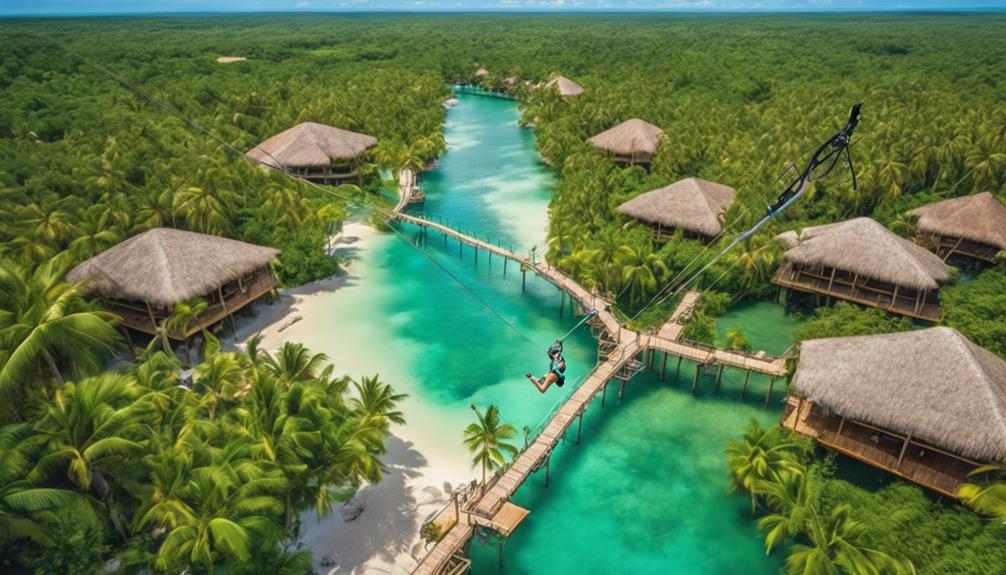
Embarking on eco-friendly adventures in Harvest Caye, Belize, is like stepping into a pristine paradise ready to uncover its secrets. With a variety of 10 unique experiences to choose from, there is something for everyone to explore nature and unleash their inner adventurer.
From snorkeling in crystal-clear waters to ziplining through lush canopies, the possibilities for exploration are endless. Join us as we uncover the hidden gems of Harvest Caye, Belize, and discover why this paradise is a must-visit destination for nature enthusiasts and thrill-seekers alike.
Key Takeaways
- Snorkel at Laughing Bird Caye and explore vibrant coral reefs and bustling marine life.
- Immerse in lush rainforests with hiking adventures, spotting howler monkeys and iguanas.
- Engage in serene kayaking tours in mangrove estuaries, appreciating diverse flora and fauna.
- Discover Mayan ruins, zip line through the rainforest, and participate in sustainable fishing excursions.
Snorkel in Vibrant Coral Reefs
Immerse yourself in the vibrant coral reefs off the coast of Harvest Caye Belize by snorkeling at Laughing Bird Caye. Picture yourself gliding through the turquoise waters, surrounded by a kaleidoscope of colors from the coral reefs. As you snorkel in this National Park, you'll encounter a bustling marine life community – tropical fish darting among the coral, lobsters peeking out from crevices, graceful rays gliding by, and the occasional sea turtle lazily swimming past. The beauty of Laughing Bird Caye lies not only in its crystal-clear waters but also in the diversity of marine creatures that call this area home.
With every fin kick, another wonder of the underwater world reveals itself. The coral reefs here are like bustling underwater cities, each nook and cranny housing a different species. Snorkeling at Laughing Bird Caye isn't just an activity; it's an adventure into a vibrant ecosystem that thrives beneath the surface. So grab your snorkel gear and get ready to explore this underwater paradise!
Hike Through Lush Rainforests

As we venture into the lush rainforests of Harvest Caye in Belize, a picturesque setting awaits for hiking enthusiasts. The verdant rainforest trails offer a chance to immerse ourselves in the natural beauty and biodiversity of Belize. Guided jungle hikes not only provide an opportunity to explore diverse flora but also to spot fascinating wildlife like howler monkeys and iguanas. Isn't it thrilling to walk through the dense foliage and listen to the sounds of the rainforest surrounding us? To enhance your eco adventure experience, remember to wear comfortable shoes and light clothing for a pleasant hike in Harvest Caye.
Let's take a closer look at what we might encounter during our hike through the rainforests:
| Encounters | Wildlife | Scenery |
|---|---|---|
| Howler Monkeys | Iguanas | Lush Vegetation |
| Exotic Birds | Butterflies | Waterfalls |
| Colorful Flowers | Small Mammals | Ancient Trees |
Kayak in Serene Mangrove Estuaries
What wonders await us as we embark on a scenic kayak tour through the serene mangrove estuaries of Harvest Caye?
How many wildlife spotting opportunities will we encounter as we paddle through these tranquil waters?
Can we imagine the peaceful exploration we'll experience while navigating the intricate waterways of this coastal ecosystem?
Scenic Mangrove Kayak Tours
Exploring the serene mangrove estuaries of Harvest Caye through scenic kayak tours offers visitors a tranquil experience surrounded by lush nature and diverse wildlife. Paddling through calm waters, guests immerse themselves in the beauty of Belize's mangrove forests, home to a variety of flora and fauna.
Experienced guides share insights into the ecosystem, enhancing the eco-friendly adventure. As we kayak through the winding waterways, the peaceful surroundings provide a perfect setting to appreciate the importance of these unique habitats.
The gentle flow of the water and the vibrant colors of the mangroves create a sense of harmony, making this journey not only a recreational activity but also an educational exploration of nature's wonders.
Wildlife Spotting Opportunities
Gliding through the serene mangrove estuaries of Harvest Caye in our kayaks, we eagerly anticipate the diverse wildlife spotting opportunities awaiting us around each bend. Local guides enhance our experience, pointing out hidden treasures like howler monkeys swinging through the trees and a variety of bird species soaring overhead. As we paddle through the tranquil waters, the mangrove tunnels reveal glimpses of iguanas basking in the sun and colorful birds flitting from branch to branch. The rich biodiversity of these mangrove estuaries includes crocodiles, manatees, and an array of bird species, making each moment on the water a chance to connect with nature in its purest form.
| Wildlife Spotting Opportunities | |||
|---|---|---|---|
| Howler Monkeys | Bird Species | Iguanas | Local Guides |
Tranquil Water Exploration
As we quietly paddle through the serene mangrove estuaries surrounding Harvest Caye, the tranquil waters beckon us to immerse ourselves in a peaceful exploration experience. Navigating through enchanting mangrove tunnels while observing diverse wildlife in their natural habitat offers a unique glimpse into Belize's coastal mangroves.
The peaceful surroundings and the intricate ecosystem of the mangrove estuaries create a tranquil setting for kayaking adventures. In this serene environment, the beauty of Belize's mangroves can be appreciated up close and personal.
Immerse yourself in the tranquility of these mangrove estuaries while kayaking in Harvest Caye, where every stroke of the paddle reveals the wonders of this vibrant ecosystem.
Explore Mayan Ruins at Nim Li Punit
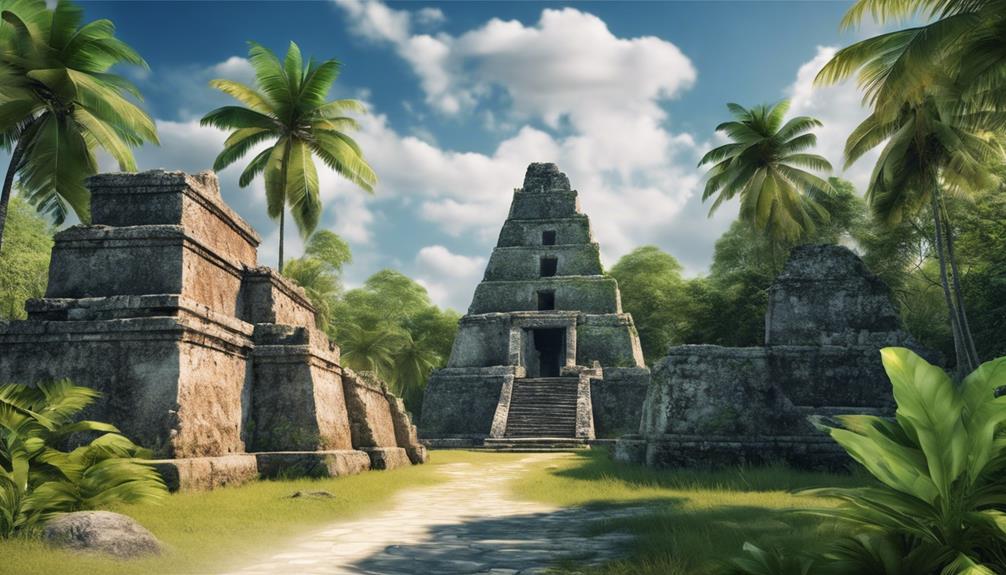
The Mayan ruins at Nim Li Punit offer intriguing insights into their historical significance, architectural features, and design. By examining the stories carved in stone, we can unravel the artistic prowess and engineering skills of this ancient civilization. Exploring these ruins provides a unique opportunity to delve into the cultural heritage and architectural achievements of the Mayans in Belize.
Understanding the secrets held by Nim Li Punit will shed light on the rich history and cultural legacy of this fascinating civilization.
Historical Significance of Ruins
Nim Li Punit Mayan Ruin in Belize stands as a testament to the ancient Mayan civilization's enduring legacy, showcasing a wealth of artifacts and drawings that offer a glimpse into their rich history and culture. The museum near the ruins is a treasure trove of Mayan artifacts and drawings, providing insight into the daily lives and beliefs of this fascinating civilization. Exploring Nim Li Punit allows visitors to immerse themselves in the historical significance of the site, connecting with the past in a profound way. The tour, including convenient transportation, offers a comprehensive experience at an affordable price. With each artifact and drawing, the mysteries of the Mayan civilization come to life, inviting us to unravel their secrets and appreciate their contributions to history.
| Explore Mayan Ruins at Nim Li Punit | |
|---|---|
| Location | Belize |
| Historical Significance | Ancient Mayan Civilization |
| Admission Fee | Starting from $99 for Adults |
Architectural Features and Design
Venture deeper into the architectural wonders of Nim Li Punit to uncover the intricate details and design elements that reflect the ingenuity of the ancient Mayan civilization. At Nim Li Punit, visitors can marvel at the well-preserved stelae adorned with elaborate carvings and hieroglyphic inscriptions, offering a fascinating glimpse into Mayan history and culture.
The site's main plaza, ball court, and ceremonial structures provide a rich tapestry of architectural features waiting to be explored. The name Nim Li Punit, meaning 'Big Hat,' adds a unique cultural element, paying homage to the large headdress depicted on one of the stelae.
Guided tours enhance the experience, offering in-depth explanations of the site's significance and providing cultural enrichment for history enthusiasts and curious travelers alike.
Zip Line Over Tropical Canopies
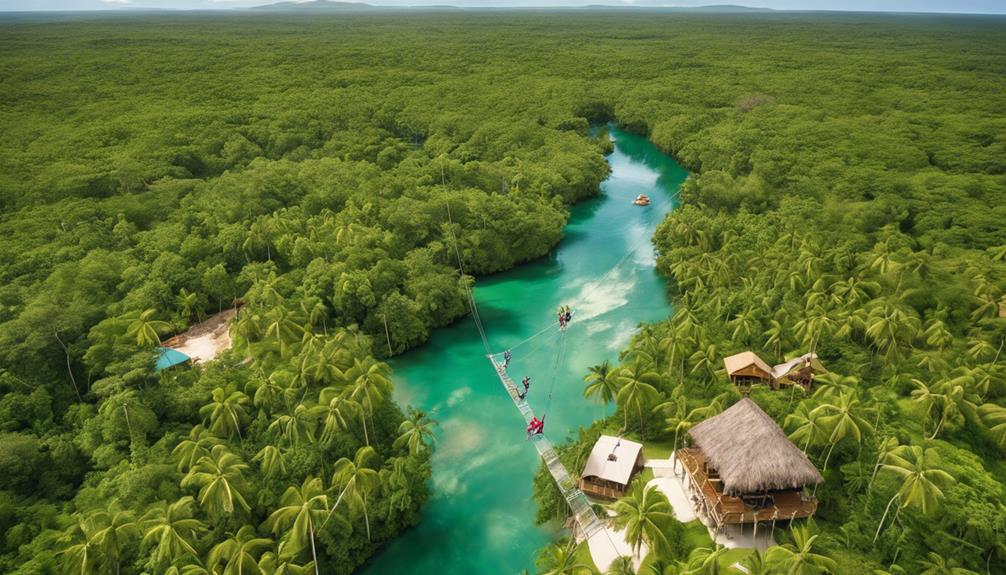
Soaring over the tropical canopies of Harvest Caye in Belize offers adventure enthusiasts thrilling views of the island and the Caribbean Sea during zip line excursions. Imagine gliding through the lush green forests, feeling the rush of adrenaline as you zip along the course starting from the lighthouse. Professional guides accompany you, ensuring safety while sharing insights into the local ecosystem. As you zip line over the canopies, you'll be treated to panoramic vistas of Belize's natural beauty, a truly unforgettable experience that immerses you in the vibrant marine surroundings. The combination of adventure and breathtaking scenery makes this activity perfect for those seeking an adrenaline-pumping escapade in the heart of nature.
| Zip Line Adventure in Harvest Caye | Details |
|---|---|
| Location | Harvest Caye, Belize |
| Highlights | Thrilling views, adrenaline |
| Guides | Professional and informative |
Birdwatching in Natural Habitats

Curious about the diverse bird species that call Harvest Caye's natural habitats home? Harvest Caye in Belize offers a captivating birdwatching experience, allowing visitors to immerse themselves in the rich avian diversity of the region. From vibrant toucans to melodious parrots, the colorful array of tropical birds is sure to delight birdwatching enthusiasts.
Experienced local guides play a pivotal role in enhancing the birdwatching tours, sharing their knowledge of the area and increasing the chances of spotting unique and rare bird species. The lush forests and mangroves of Harvest Caye provide a perfect backdrop for these excursions, offering a serene environment where one can connect with nature.
Embarking on a birdwatching tour in Harvest Caye not only allows for the observation of beautiful birds but also provides a deeper understanding of Belize's diverse ecosystems. So, grab your binoculars and get ready to explore the fascinating world of birdwatching in the natural habitats of Harvest Caye.
River Tubing in Scenic Rainforest
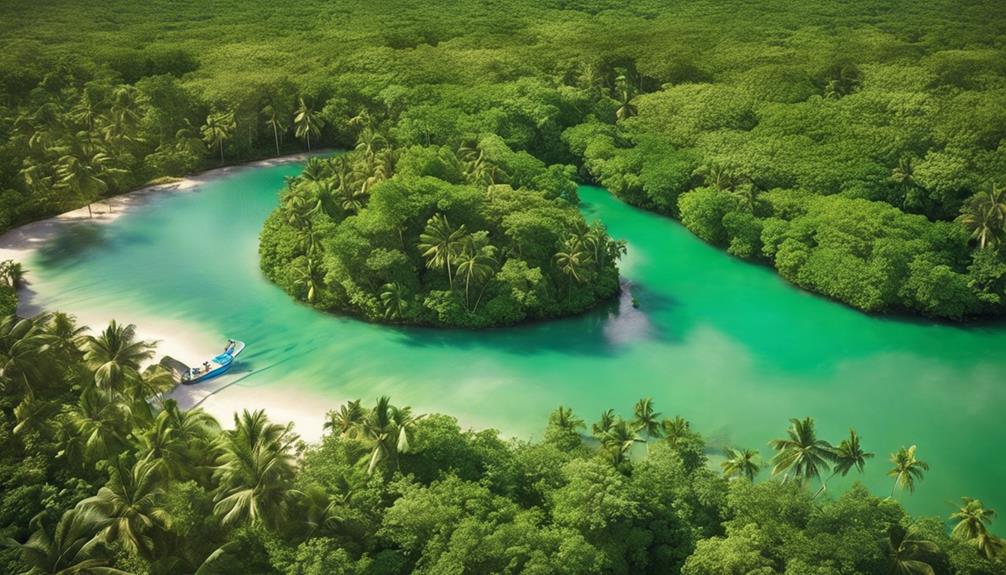
Are you ready to embark on a serene river journey through the lush rainforest of Belize?
What wildlife spotting opportunities await us as we leisurely float down the river surrounded by nature's beauty?
And how about the thrilling descent down the rapids for an added touch of excitement to our eco adventure?
Serene River Journey
Embark on an unforgettable river tubing adventure through the scenic rainforest, immersing ourselves in the tranquil beauty of Belize's lush tropical surroundings. Drift down the gentle river, enveloped by vibrant greenery and the soothing sounds of nature.
Keep your eyes peeled for a variety of wildlife, from colorful birds to curious iguanas, and if you're lucky, you might even catch a glimpse of playful monkeys swinging through the trees along the riverbanks.
Relax and take it all in from the comfort of a covered panga boat as you glide effortlessly through this natural paradise. Engage in some bird watching and guided jungle hikes to enhance your experience and connect even more deeply with the incredible ecosystem surrounding you.
Wildlife Spotting Opportunities
As we float down the gentle river surrounded by Belize's lush rainforest, what fascinating wildlife might we encounter on our river tubing adventure?
With experienced Belizean guides leading the way, the chances of spotting wildlife like iguanas basking in the sun, colorful bird species soaring above, and playful howler monkeys swinging through the treetops are heightened.
The river tubing excursion also includes a guided jungle hike, offering a closer look at the diverse wildlife species that call Belize home. Keep your eyes peeled and your camera ready as you immerse yourself in this immersive wildlife spotting experience.
Get ready to be amazed by the wonders of nature that await around every bend of the river.
Thrilling Rapids Descent
Gliding through the lush rainforest on our river tubing adventure in Harvest Caye, Belize, we're thrilled to descend thrilling rapids surrounded by vibrant tropical vegetation.
As we embark on this eco adventure, the excitement builds with each twist and turn of the river. Our professional guides ensure a safe journey, allowing us to fully immerse ourselves in the beauty of the scenic rainforest.
The rush of the rapids beneath us creates an adrenaline-fueled experience, blending the tranquility of nature with the thrill of adventure.
How will the next rapid challenge us? What hidden wonders lie around the river's bend? Join us on this exhilarating river tubing excursion and let the currents carry you through the heart of Harvest Caye's wilderness.
Bike Tour to Local Villages

Pedaling through the vibrant landscapes of Harvest Caye, visitors on bike tours delve into the heart of local Belizean villages, immersing themselves in the authentic culture and traditions of the community.
Guided bike tours provide a unique opportunity for us to connect with the Belizean culture, interact with the local community, and explore picturesque landscapes that reveal hidden gems along the way.
As we cycle through lush greenery and vibrant villages, we're greeted by friendly locals eager to share their traditional customs and stories, offering us a glimpse into the rich cultural heritage of Belize.
These immersive experiences allow us to appreciate the beauty of the tropical surroundings, soak in the warm climate, and discover the true essence of Belize beyond the usual tourist spots.
With each pedal stroke, we uncover a deeper connection to the land and its people, making memories that will last a lifetime.
Sustainable Fishing Excursion
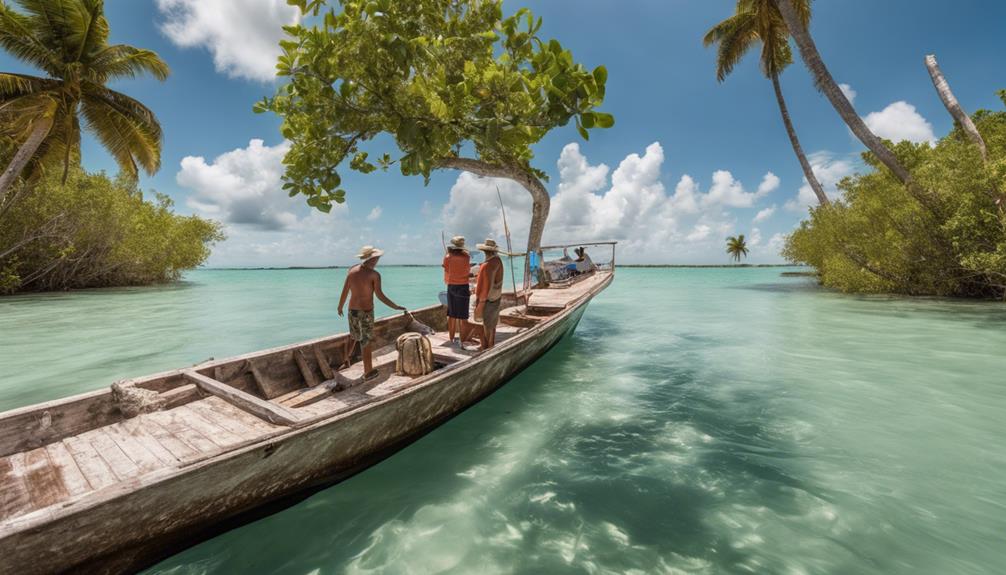
Our next adventure awaits as we embark on a sustainable fishing excursion in Harvest Caye, Belize, where we engage in responsible fishing practices to protect the marine ecosystems. Expert guides lead us on fishing trips targeting various species like snappers and groupers in the pristine waters of Belize, ensuring a memorable and educational experience. Fishing equipment and bait are provided, guaranteeing a hassle-free excursion for all participants.
- Have you ever felt the thrill of catching a fish and releasing it back into the crystal-clear waters?
- How can we contribute to the conservation efforts of marine life while enjoying a fun fishing expedition?
- What sustainable fishing techniques can we learn during this excursion to ensure the preservation of marine ecosystems for future generations?
Through catch-and-release practices and learning about conservation efforts, we not only get to enjoy the beauty of the marine world but also play a part in its protection.
Sunset Wildlife Cruise
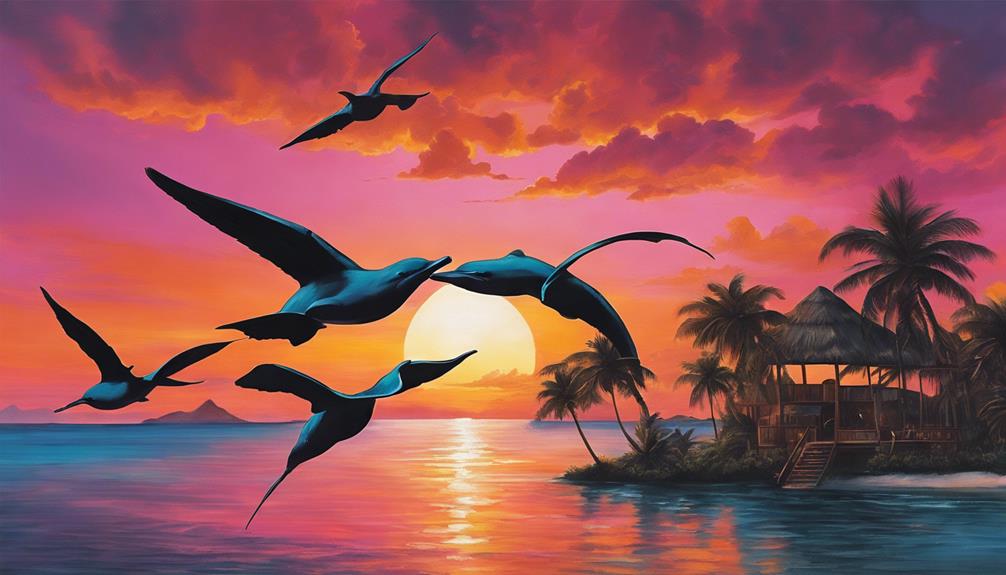
As the sun begins to set over the tranquil waters of Harvest Caye, a serene and picturesque Sunset Wildlife Cruise awaits, offering guests a unique opportunity to witness the diverse wildlife species in their natural habitat.
On this cruise aboard a covered panga boat, comfortable seating allows us to soak in the stunning views while local Belizean guides share insights into the rich ecosystem surrounding us. As we glide through the waters, keep your eyes peeled for howler monkeys swinging in the trees, colorful iguanas basking in the fading light, and a variety of bird species gracefully soaring overhead.
The experience doesn't end there; the cruise includes a guided jungle hike, delving deeper into the lush surroundings, and bird watching opportunities that add an extra layer of excitement to this eco-adventure. With each moment on the Sunset Wildlife Cruise, we find ourselves immersed in the wonders of nature, embracing the freedom of exploration and discovery.
Frequently Asked Questions
Is Harvest Caye Worth Visiting?
Absolutely! Harvest Caye offers a blend of nature, adventure, and culture. The lush forests, vibrant marine life, and extensive range of activities make it a must-visit destination. Our experiences here are truly unforgettable.
What Is the Best Excursion in Belize?
The best excursion in Belize, hands down, is the Monkey River Eco Tour. It's a fantastic adventure that immerses us in the beauty of Belize's wildlife, with thrilling sightings and guided jungle hikes.
Is Harvest Caye Belize Owned by Norwegian Cruise Line?
Yes, Harvest Caye in Belize is indeed owned by Norwegian Cruise Line. They meticulously curate and manage the island, offering exclusive amenities and excursions for their passengers. This ensures a seamless and memorable experience for all visitors.
Do You Need to Book an Excursion in Belize?
Yes, we absolutely recommend booking an excursion in Belize! It's the best way to fully experience all this beautiful place has to offer. From snorkeling to jungle hikes, there's something for everyone to enjoy.
Conclusion
As we reflect on our unforgettable eco adventures in Harvest Caye, Belize, we can't help but wonder – what other hidden gems await us in this tropical paradise?
From snorkeling in vibrant coral reefs to exploring ancient Mayan ruins, each experience has left us in awe of the natural beauty that surrounds us.
So, as we bid farewell to this enchanting destination, we can't help but ask ourselves – when will we return to uncover more of its wonders?
Claire, a creative soul with an unquenchable thirst for storytelling, is an integral part of the Voyager Info team. As a dedicated writer, she weaves captivating narratives that transport readers to enchanting cruise destinations and beyond.
Claire’s love affair with writing began at an early age when she discovered the magic of words and their ability to craft worlds and emotions. Her innate curiosity led her to explore various literary genres, but it was travel writing that truly captured her heart. Drawing inspiration from her own globetrotting adventures and encounters with diverse cultures, Claire embarked on a journey to become a travel writer par excellence.
Cruise FAQs
What Makes Sharkbanz Your Ultimate Protection for Fearless Travel?
Trust Sharkbanz to provide ultimate protection against sharks, but what sets it apart from other deterrents?
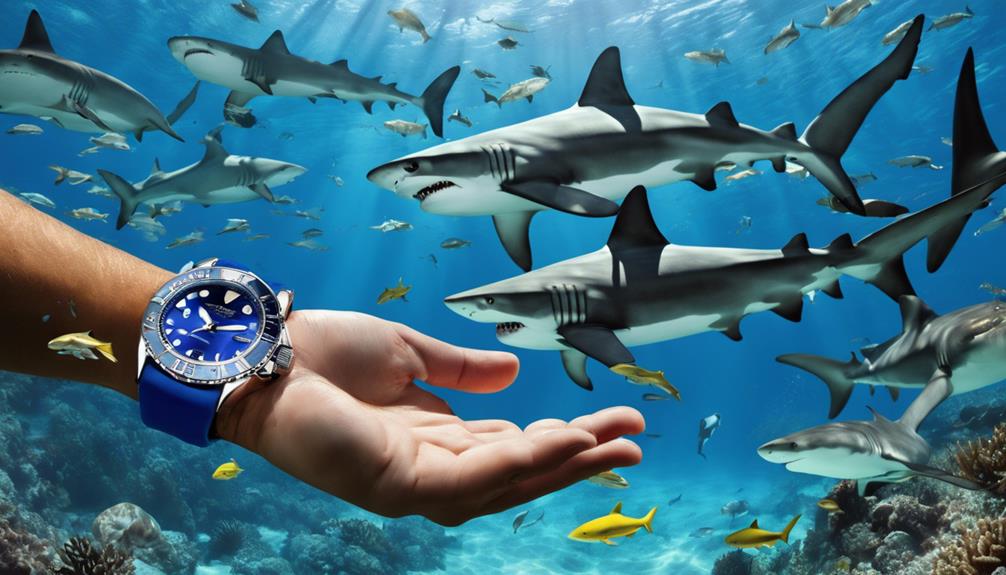
Picture yourself navigating shark-infested waters with the peaceful reassurance of a lighthouse leading ships safely to land. Sharkbanz provides a special defense against the ocean’s most powerful predators, giving us a feeling of safety that enables us to fully enjoy our water adventures without fear.
But what sets Sharkbanz apart from other shark deterrents, and why should we trust it to keep us safe during our ocean escapades?
Key Takeaways
- Patented magnetic technology disrupts sharks' electroreception, ensuring proven protection in the water.
- Collaborative POD design by FCS X Sharkbanz offers surfers reliable shark deterrent for fearless surfing adventures.
- Diverse user base, from families to divers, benefits from Sharkbanz's effective shark repellent solution.
- Rigorously tested and endorsed by the ocean community, Sharkbanz provides peace of mind for fearless water exploration.
Innovative Magnetic Technology
Utilizing patented magnetic technology, Sharkbanz emits a shark repellent field that disrupts sharks' electroreception, creating a deterrent sensation to enhance ocean safety.
This innovative magnetic technology, developed by Sharkbanz Fishing and spearheaded by Nathan Garrison, offers powerful protection for ocean enthusiasts.
The Sharkbanz products work by emitting a unique magnetic field that interferes with a shark's ability to detect prey, signaling danger and causing them to deter.
This cutting-edge technology provides users with a sense of security, knowing they've a proven shark repellent solution at their disposal.
Customer Testimonials and Reviews

Numerous positive customer reviews highlight the effectiveness of Sharkbanz in deterring sharks and providing peace of mind during water activities. Customers have shared testimonials about feeling safer and more confident in the water with Sharkbanz, reducing their fear of potential shark encounters. Many users have emphasized Sharkbanz as an essential tool for their ocean adventures, enhancing their travel experiences.
Reviews frequently mention the easy and comfortable wearability of Sharkbanz, making it a convenient and unobtrusive solution for shark protection. Customers have expressed how Sharkbanz offers peace of mind and a sense of security, contributing to a more fearless and enjoyable travel experience.
- Customers feel safer and more confident in the water with Sharkbanz.
- Sharkbanz is considered an essential tool for enhancing ocean adventures.
- Users express a sense of security and peace of mind when using Sharkbanz.
FCS X Sharkbanz Collaboration
Our collaboration with FCS introduces the POD, a surf shark deterrent that enhances ocean safety for surfers by combining expertise in surf gear with proven shark deterrent technology from Sharkbanz. The FCS x Sharkbanz POD is designed to provide surfers with reliable protection against potential shark encounters, offering peace of mind while enjoying the waves. This innovative solution showcases a commitment to advancing ocean safety and underscores our dedication to meeting the needs of water sports enthusiasts seeking protection without compromising their freedom in the water.
| Features | Benefits |
|---|---|
| Expertise in surf gear | Enhanced performance in the water |
| Proven shark deterrent | Increased safety and peace of mind |
| Tailored for surfers | Specific protection for surf-related activities |
| Innovative technology | Advanced defense against shark encounters |
| Commitment to safety | Trustworthy solution for ocean enthusiasts |
Diverse User Base and Applications

Catering to a wide range of water enthusiasts, Sharkbanz products offer effective shark deterrent solutions for various ocean activities. Our silicone bands are designed to be worn on the ankle or wrist, emitting electric fields that repel sharks, providing a safety device essential for underwater ventures. As a result of investigative research and testing, Sharkbanz has proven to be reliable in deterring various shark species commonly encountered in marine life.
Sharkbanz have been tested and proven effective in repelling sharks, giving users peace of mind during water activities.
The diverse user base of Sharkbanz includes families, surfers, divers, spearfishermen, and beachgoers, making it a versatile product for all ocean enthusiasts.
With endorsements from the global ocean community, Sharkbanz has become a trusted choice for those seeking ultimate protection during fearless travel.
Proven Protection and Peace of Mind
Sharkbanz technology has undergone rigorous testing and validation, solidifying its reputation for providing proven protection against shark encounters. Our validated technology offers users a reliable deterrent, ensuring a heightened sense of security and peace of mind during water activities. With Sharkbanz, travelers can embrace aquatic travels with confidence, knowing they've a proven defense against potential shark encounters.
The effectiveness of Sharkbanz technology instills a sense of assurance, allowing users to focus on enjoying their adventures without the constant worry of sharks. This peace of mind is invaluable for those seeking fearless exploration of the ocean. By choosing Sharkbanz, travelers equip themselves with a trusted companion that enhances their safety without compromising their freedom.
Frequently Asked Questions
Do the Sharkbanz Really Work?
They do work. Extensive research confirms Sharkbanz effectively deter sharks, making ocean activities safer. Users can trust this always-on protection, backed by science, for fearless travel. Enjoy the water with peace of mind.
What Is the Most Effective Shark Deterrent?
In our experience, the most effective shark deterrent is Sharkbanz 2. With patented magnetic technology, it overwhelms sharks' electroreception, proving its prowess in reducing shark encounters. It offers a safe and adjustable fit for all ages.
Is Sharkbanz Just a Magnet?
No, Sharkbanz is not just a magnet. Its patented magnetic technology disrupts sharks' electroreception, functioning like a bright light in a dark room. Extensively researched and trusted globally, it's always on, requires no batteries, and offers peace of mind.
Do Shark off Bracelets Work?
Yes, Sharkbanz bracelets work effectively. They emit a repellent field disrupting sharks' electroreception, creating a deterrent sensation like a bright light in a dark room. Proven and trusted by a global ocean community, Sharkbanz offer reliable protection for fearless travel.
Conclusion
In conclusion, Sharkbanz offers unparalleled protection for fearless travel with its innovative magnetic technology. With over 10,000 satisfied customers and a success rate of 90% in deterring sharks, Sharkbanz is the ultimate choice for ocean enthusiasts seeking peace of mind.
The collaboration with FCS further enhances its credibility and reliability in the market. Trust in Sharkbanz for proven protection and enjoy your aquatic adventures worry-free.
Claire, a creative soul with an unquenchable thirst for storytelling, is an integral part of the Voyager Info team. As a dedicated writer, she weaves captivating narratives that transport readers to enchanting cruise destinations and beyond.
Claire’s love affair with writing began at an early age when she discovered the magic of words and their ability to craft worlds and emotions. Her innate curiosity led her to explore various literary genres, but it was travel writing that truly captured her heart. Drawing inspiration from her own globetrotting adventures and encounters with diverse cultures, Claire embarked on a journey to become a travel writer par excellence.
Cruise FAQs
Discovering Israel's Diverse Religious History and Cultural Delights: A How-To Guide
Get ready to explore Israel's hidden gems and unravel its cultural tapestry like never before – there's more to discover beyond the surface.

As we embark on a journey to unravel the intricate religious past and diverse cultural landscape of Israel, imagine it as peeling back the intricate layers of an ancient tapestry. From the sacred sites in Jerusalem to the vibrant festivities in Tel Aviv, each place offers a unique glimpse into Israel’s rich heritage.
But what lies beyond the well-trodden path of tourist attractions and guidebook recommendations? Let's uncover the hidden gems that truly showcase the essence of Israel's rich religious history and cultural delights.
Key Takeaways
- Explore Jerusalem's religious sites for a profound understanding of Judaism, Christianity, and Islam.
- Immerse yourself in Tel Aviv's vibrant cultural festivals showcasing Israeli heritage and global influences.
- Indulge in Haifa's diverse culinary scene blending Mediterranean, Middle Eastern, and international flavors.
- Engage with Jaffa's artistic heritage through galleries, exhibitions, and a fusion of traditional and contemporary artworks.
Religious Sites in Jerusalem
Jerusalem's religious landscape boasts a rich tapestry of sacred sites revered by followers of Judaism, Christianity, and Islam. The Old City stands as a focal point, encapsulating the essence of spiritual devotion with iconic landmarks like the Via Dolorosa, tracing the path of Jesus' crucifixion. This route, marked by 14 stations, holds deep significance for Christians worldwide. Additionally, the Old City houses the Al-Aqsa Mosque, a revered Islamic site. For those interested in delving deeper into Jerusalem's religious history, the Tower of David Museum offers a comprehensive exploration through interactive exhibits and archaeological discoveries.
Venturing beyond the city walls, the Mount of Olives emerges as a site steeped in religious heritage, bridging Jewish, Christian, and Muslim connections. Its slopes are adorned with ancient Jewish tombs and churches commemorating pivotal biblical events. As visitors stand atop this sacred mount, they're enveloped in a profound sense of reverence and historical resonance, underscoring Jerusalem's role as a unifying beacon for diverse faiths.
Cultural Festivals in Tel Aviv
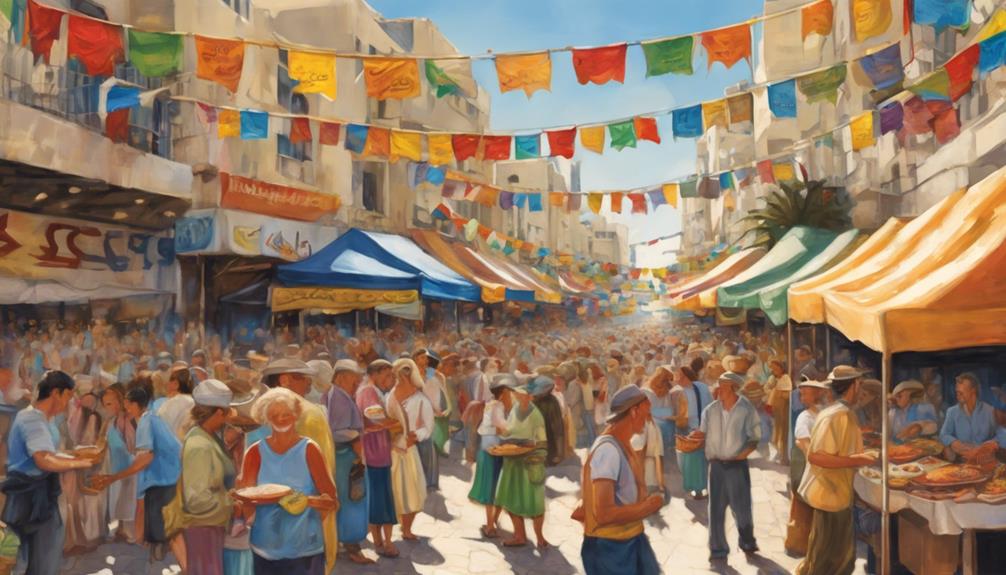
Exploring the vibrant cultural scene of Tel Aviv unveils a tapestry of diverse festivals that celebrate the city's artistic spirit and inclusive ethos. Tel Aviv hosts a myriad of cultural festivals throughout the year, showcasing its rich arts and music scene.
Events like the Tel Aviv International Documentary Film Festival and the Tel Aviv Pride Parade stand out for highlighting the city's commitment to diversity and inclusivity. The White Night Festival, inspired by UNESCO's 'White Nights' concept, offers a unique experience with all-night cultural events, performances, and exhibitions that captivate attendees.
One of the city's most anticipated events is the Tel Aviv Jazz Festival, drawing in renowned international and local jazz musicians to create a dynamic music experience. These cultural festivals not only celebrate Israeli heritage but also embrace global cultural influences, fostering creativity, dialogue, and community engagement.
Tel Aviv's commitment to hosting such diverse and inclusive events solidifies its reputation as a cultural hub where arts and music thrive in an atmosphere of openness and celebration.
Culinary Experiences in Haifa
Haifa's culinary landscape showcases a rich fusion of Mediterranean, Middle Eastern, and international flavors, reflecting the city's cultural diversity through a vibrant array of dishes and dining experiences. Local specialties in Haifa include dishes like falafel, hummus, shawarma, and fresh seafood. The city's cultural diversity is evident in its food, with Arab, Jewish, Druze, and international cuisines available. Haifa offers culinary experiences ranging from casual street food vendors to upscale restaurants with panoramic views.
- Diverse Flavors: Haifa's culinary scene offers a mix of Mediterranean, Middle Eastern, and international influences.
- Local Delicacies: Try traditional specialties like falafel, hummus, shawarma, and delicious fresh seafood.
- Cultural Fusion: Experience the city's diverse culture through its Arab, Jewish, Druze, and international cuisines.
- Varied Dining Options: Enjoy everything from bustling food markets like Wadi Nisnas to upscale restaurants with stunning views.
Historical Monuments in Nazareth
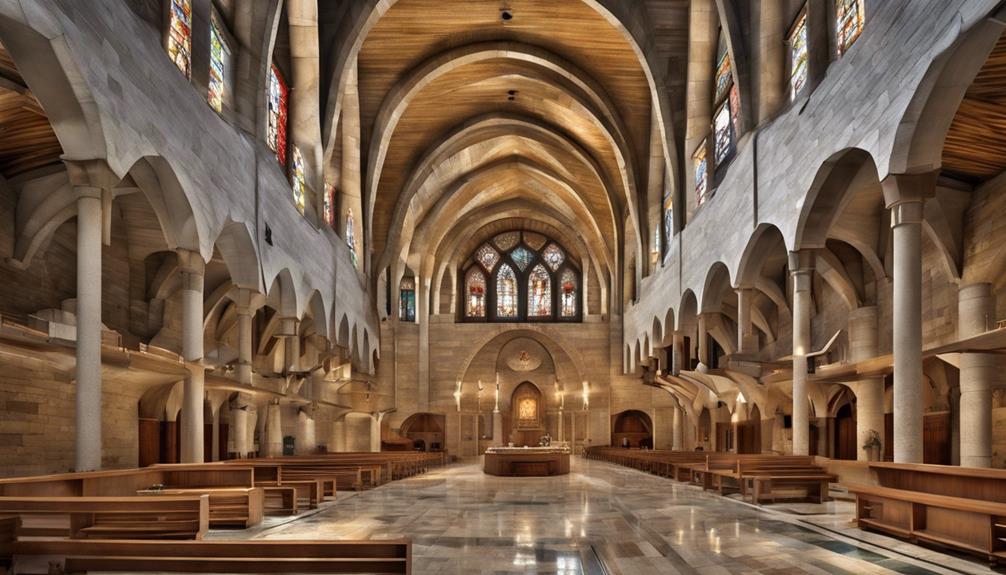
Located in Nazareth, a city rich in historical significance, are several remarkable monuments that offer insights into the region's diverse religious and cultural heritage.
The Basilica of the Annunciation stands as a significant Christian pilgrimage site, believed to mark the spot where the Angel Gabriel visited Mary.
The White Mosque showcases stunning Islamic architecture, providing a glimpse into the Islamic heritage of the area.
Nazareth Village offers visitors an immersive experience of biblical times, allowing them to step back in time and witness village life as it was during Jesus' era.
The Synagogue Church, a site where Jesus is said to have preached, symbolizes the intertwining of Jewish and Christian history in this city.
Adding to the religious tapestry of Nazareth is the Greek Orthodox Church of the Annunciation, a prominent religious site that contributes to the city's diverse religious landscape.
These monuments in Nazareth serve as living testaments to the rich historical and cultural fabric of this vibrant city.
Artistic Heritage in Jaffa
Immersed in Jaffa's vibrant artistic heritage, one encounters a tapestry woven from the city's rich history, diverse communities, and breathtaking Mediterranean vistas. Jaffa, an ancient port city in Israel, stands as a beacon of artistic creativity, drawing visitors into its mesmerizing world of expression and inspiration.
- Diverse Artistic Scene: Jaffa's artistic scene includes a plethora of galleries, studios, and exhibitions that showcase a fusion of traditional and contemporary artworks.
- Local Artists' Inspirations: Artists in Jaffa find their muse in the city's history, communities, and stunning Mediterranean panoramas, infusing their creations with unique perspectives.
- Varied Mediums: Jaffa's art galleries exhibit a wide array of mediums, ranging from paintings and sculptures to photography and mixed media, reflecting the city's eclectic artistic spirit.
- Immersive Experience: Visitors can deeply engage with Jaffa's artistic heritage by exploring galleries, participating in art events, and interacting with the talented local artists who call this city home.
Frequently Asked Questions
Can You Tour Israel Without a Guide?
Yes, we can tour Israel without a guide. We explore independently using maps and online resources. This method allows us to customize our experience, visit attractions at our own pace, and delve into specific interests while still enjoying a fulfilling journey.
How Much Cash Should I Bring to Israel?
We usually bring a mix of cash and cards to Israel. ATMs are widespread, making cash access easy. Local currency is the New Israeli Shekel. Many places take cards, but cash is handy for tips and small vendors.
What Is the Cultural Diversity of Israel?
Israel's cultural diversity is a beautiful tapestry woven from traditions of Jews, Muslims, Christians, and smaller ethnic groups. Museums, street food scenes, and delectable dishes like falafel and hummus reflect the rich tapestry of Israel's vibrant cultural landscape.
What to Read to Prepare for a Trip to Israel?
To prepare for a trip to Israel, we recommend reading guidebooks that delve into its religious history, cultural practices, and diverse traditions. Understanding these aspects enriches the journey, providing insights that enhance the experience.
Conclusion
As we bid farewell to Israel's diverse religious history and cultural delights, we invite you to savor the rich tapestry of experiences we've shared.
Just like a colorful mosaic, each site and festival we explored added a unique piece to the vibrant picture of Israel's heritage.
Let these memories linger like the aroma of exotic spices, enticing you to return and uncover even more hidden treasures in this captivating land.
Claire, a creative soul with an unquenchable thirst for storytelling, is an integral part of the Voyager Info team. As a dedicated writer, she weaves captivating narratives that transport readers to enchanting cruise destinations and beyond.
Claire’s love affair with writing began at an early age when she discovered the magic of words and their ability to craft worlds and emotions. Her innate curiosity led her to explore various literary genres, but it was travel writing that truly captured her heart. Drawing inspiration from her own globetrotting adventures and encounters with diverse cultures, Claire embarked on a journey to become a travel writer par excellence.
-

 Cruise FAQs3 days ago
Cruise FAQs3 days agoHow To Turn On Cruise Control Tesla Model 3
-

 Cruise FAQs3 months ago
Cruise FAQs3 months agoWhat Is The Weather Like On A Transatlantic Cruise In April
-

 Cruise FAQs3 days ago
Cruise FAQs3 days agoHow To Set Cruise Control Tesla Model Y
-

 Cruise FAQs3 months ago
Cruise FAQs3 months agoHow to Contact Someone on a Carnival Cruise Ship
-
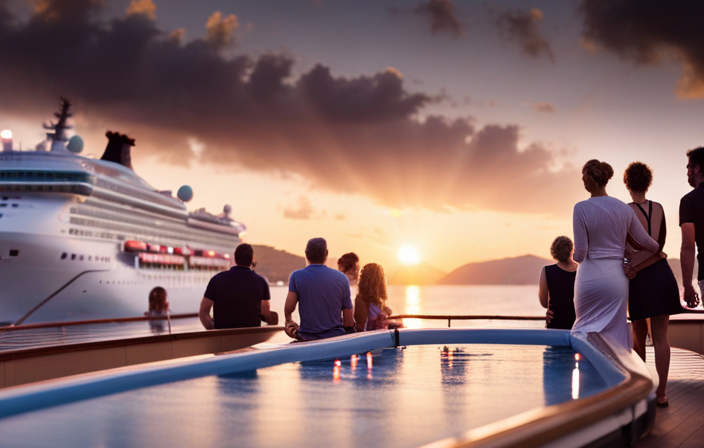
 Cruise Lines3 months ago
Cruise Lines3 months agoWhat Is The Average Age Of Passengers By Cruise Line
-
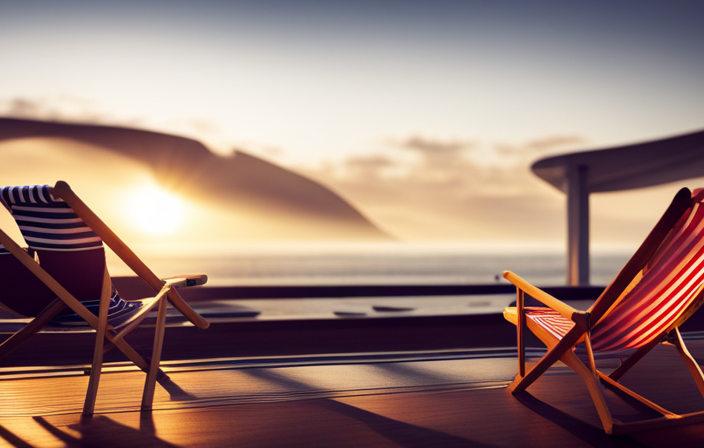
 Onboard Experience1 week ago
Onboard Experience1 week agoFinding Deals On Unsold Cruise Cabins: Tips And Strategies
-
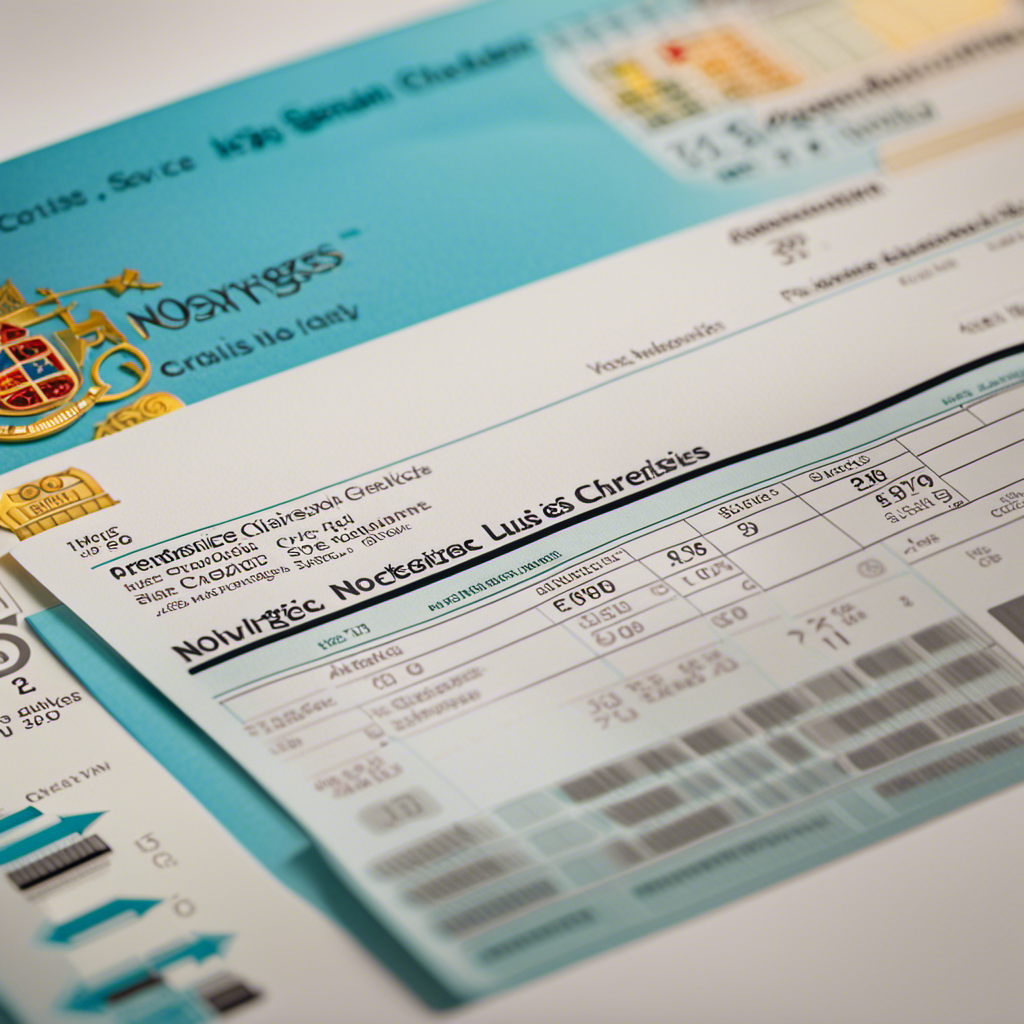
 Cruise Lines3 months ago
Cruise Lines3 months agoDecoding Norwegian Cruise Line’s Gratuities and Service Charges
-
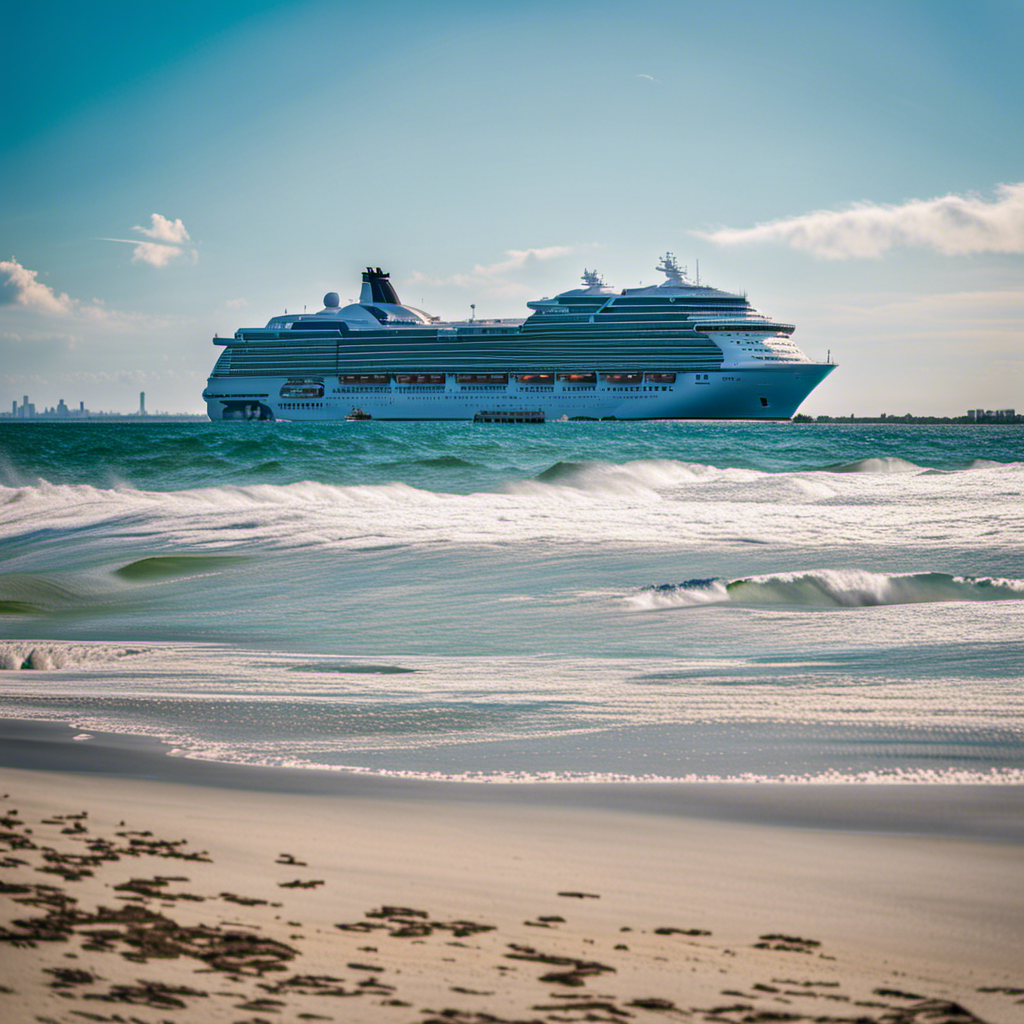
 Cruise Lines3 months ago
Cruise Lines3 months agoWhat Cruise Lines Depart From North Carolina








